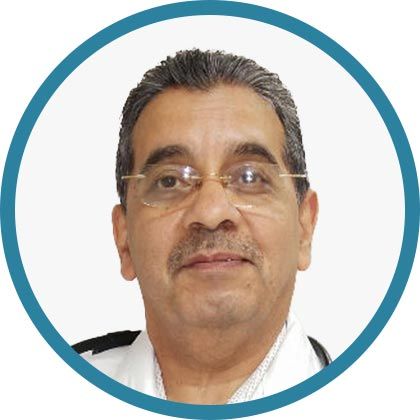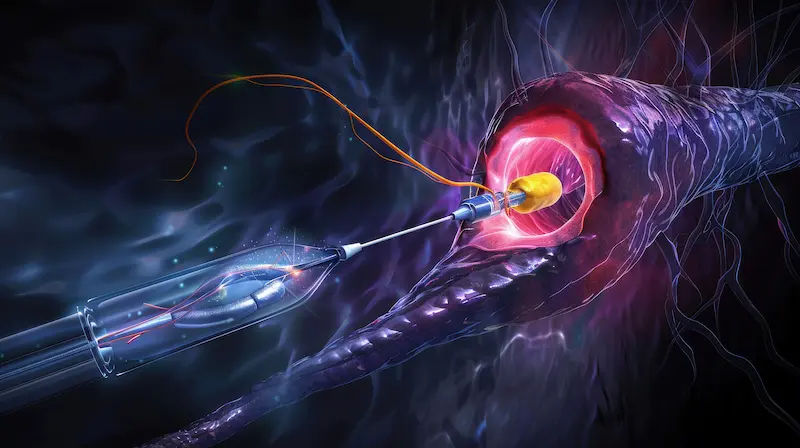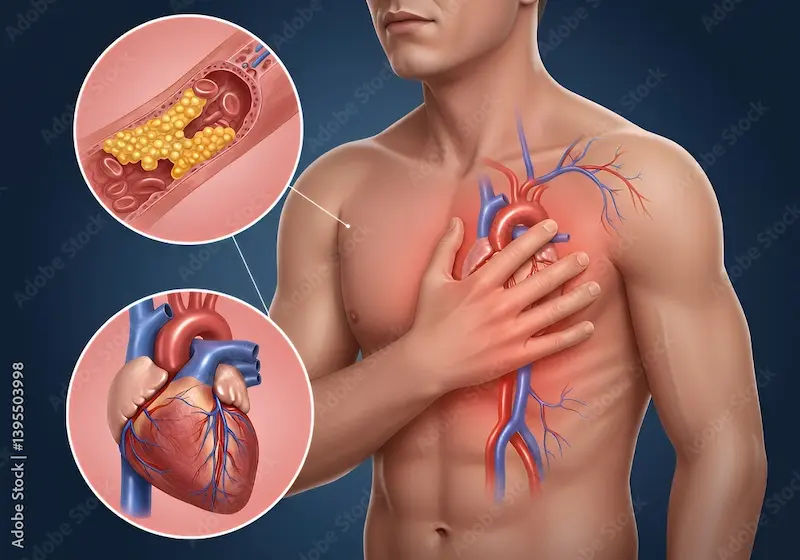What Leads To Signs Of Heart Attack
Learn the critical causes and early warning signs of a heart attack. Discover key risk factors, lifestyle changes, and when to seek immediate emergency medical help.

Written by Dr. Mohammed Kamran
Reviewed by Dr. D Bhanu Prakash MBBS, AFIH, Advanced certificate in critical care medicine, Fellowship in critical care medicine
Last updated on 24th Oct, 2025

Introduction
Heart attack signs rarely come out of nowhere. Most often, they’re the result of a chain of events inside the coronary arteries: cholesterol-filled plaque becomes unstable, a blood clot forms, and blood flow to heart muscle is suddenly blocked. The result—called a myocardial infarction—can cause classic chest pressure, shortness of breath, sweating, nausea, or pain moving to the arm, neck, jaw, or back. But heart attack signs aren’t always textbook, especially in women, older adults, and people with diabetes. Understanding what leads to the signs of a heart attack helps you recognize trouble sooner, call for help faster, and lower your risk in the first place.
This comprehensive guide explains what a heart attack is, why it happens, and how symptoms develop. You’ll learn the classic and subtle warning signs, who’s most at risk, what to do at home in the first minutes, and how doctors diagnose and treat heart attacks. We’ll also cover preventive strategies, common myths, and how to tell a heart attack from anxiety or heartburn. If you suspect a heart attack at any point, call your local emergency number immediately—minutes matter.
Understanding what a heart attack is—and why it happens
The short version
• A heart attack (myocardial infarction) happens when blood flow in a coronary artery drops sharply or stops, depriving part of the heart muscle of oxygen. Within minutes, muscle cells are injured; within hours, they can die. The most common cause is plaque rupture and a sudden blood clot that blocks the artery. Less often, spasm, dissection, or a supply-demand mismatch triggers injury.
Plaque rupture, clotting, and the “ticking clock”
• Over years, LDL cholesterol, inflammation, and high blood pressure contribute to atherosclerotic plaque. Some plaques have thin caps and large lipid cores—more likely to rupture. When a cap tears, platelets stick and a clot forms, choking off blood flow. Pain and other signs begin when oxygen-starved heart muscle releases distress signals. This is why delays increase damage—the longer the artery stays closed, the greater the infarct size.
Types of heart attack you may hear about (NSTEMI vs STEMI explained)
• STEMI:
a full-thickness injury with a completely blocked artery—needs urgent angioplasty (PCI) to reopen the artery.
• NSTEMI:
partial blockage or smaller artery—still serious and often treated with medicines and early catheterization.
Unique insight
Not all heart attacks look the same inside the artery. A subset called MINOCA (myocardial infarction with non obstructive coronary arteries) can occur with spasm, microvascular dysfunction, or clot that dissolves before angiography. Symptoms can be identical; evaluation still requires urgency.
Consult a Top General Physician
The classic and atypical signs of a heart attack
Classic “textbook” symptoms
• Pressure, tightness, squeezing, or heaviness in the center or left side of the chest lasting more than a few minutes or that goes away and comes back.
• Pain or discomfort spreads to the shoulders, arm (often left), neck, jaw, or back.
• Shortness of breath, cold sweat, nausea, lightheadedness.
Early signs of a heart attack in women and older adults
• Women may be more likely to report shortness of breath, unusual fatigue, indigestion-like discomfort, back or jaw pain—sometimes without severe chest pain. Older adults and people with diabetes may have subtler or “silent heart attack” symptoms. Don’t dismiss atypical signs.
Heart attack warning signs at night and “comes-and-goes” symptoms
• Symptoms may occur at rest, during sleep, or with mild exertion, sometimes waxing and waning as the artery intermittently opens and closes (unstable angina/prodromal symptoms).
When to call emergency services
• If you have chest discomfort plus any of the signs above—especially if lasting more than 5 minutes—call your local emergency number immediately. Do not drive yourself. Chewing aspirin may be advised by emergency dispatch; follow their guidance.
LSI terms included:
early signs of a heart attack in women; silent heart attack symptoms
Early warning signs and what leads up to them
The “prodrome” many people miss
• Hours to days before a heart attack, some notice new or worsening chest pressure with activity, unusual shortness of breath, or fatigue. These can be unstable angina—temporary, partial reductions in blood flow that precede a complete blockage. Treat any new chest discomfort with urgency.
Triggers that can tip the balance
• Physical exertion in cold weather (e.g., shoveling snow), sudden emotional stress or anger, large meals, and abrupt temperature changes can trigger symptoms by raising heart workload or provoking spasm.
• Smoking, air pollution, and infections (like flu) increase inflammation and can make plaques more rupture-prone. If you’re at risk, take extra precautions during high-smog days or illnesses.
Circadian timing: morning risk
• There’s a known morning surge in heart rate, blood pressure, and clotting tendency—one reason heart attacks are more common in early hours. This doesn’t change what to do; it reinforces the importance of taking prescribed morning medicines consistently.
Practical tip
Keep a “symptom diary” when you notice exertional chest pressure or unexplained breathlessness. If symptoms persist beyond two weeks or worsen, consult a doctor online with Apollo24|7 for further evaluation, and seek urgent care if symptoms are severe or new.
Who’s most at risk and why
Modifiable risk factors
• Smoking or vaping nicotine, high LDL cholesterol, high blood pressure, diabetes or prediabetes, obesity, sedentary lifestyle, unhealthy diet (high in trans fats/ultra-processed foods), and chronic stress all raise heart attack risk. Managing these can dramatically lower risk.
Non-modifiable risk factors
• Age, male sex (earlier risk), family history of premature coronary disease, and certain genetic conditions increase susceptibility. Women’s risk rises after menopause.
Medical conditions that amplify risk
• Chronic kidney disease, inflammatory disorders (e.g., rheumatoid arthritis), sleep apnea, pregnancy-related complications (preeclampsia, gestational diabetes), and depression are linked to higher risk.
Diabetes and silent MI
• Nerve changes in diabetes can blunt pain, leading to silent heart attack symptoms such as breathlessness, fatigue, or sudden sweating without chest pain. Maintain regular checkups and strict control of blood sugar, BP, and cholesterol.
Where testing fits
If you have risk factors, periodic checks of lipid profile, HbA1c, and blood pressure are crucial. Apollo24|7 offers convenient home collection for tests like lipid panel and HbA1c to support preventive care.
What to do during a suspected heart attack at home
The first five minutes: do this
• Stop what you’re doing, sit or lie down, and call your emergency number immediately. Using emergency medical services is safer than driving and allows fast treatment en route.
Aspirin: yes—but only when advised
• If an emergency operator advises it, chew one adult aspirin (typically 300–325 mg) unless you’re allergic or have been told not to. Aspirin helps inhibit clot growth, buying time. Do not self-medicate with other pain relievers.
What not to do
• Don’t drive yourself or wait to “see if it passes.” Don’t take nitroglycerin unless prescribed. Don’t ignore symptoms that come and go—intermittent chest pressure can precede a full blockage.
Preparing ahead
• Keep a list of medicines and allergies in your wallet and on your phone. Share emergency contacts with family. If you’ve been prescribed nitroglycerin for angina, review with your doctor how and when to use it.
LSI terms included: what to do during a heart attack at home; aspirin for suspected heart attack
How doctors confirm and treat a heart attack
Diagnosis: speed matters
• ECG within minutes:
identifies STEMI vs NSTEMI and guides urgent treatment.
• Cardiac troponin test:
a highly specific blood test for heart muscle injury. Serial troponins over a few hours confirm diagnosis when the ECG is nondiagnostic. [4][5][7]
• Additional tests:
echocardiogram to assess heart function; coronary angiography to view blockages.
Treatment:
reopening the artery and protecting the heart
• For STEMI:
emergency angioplasty (PCI) with stent is preferred; clot-busting drugs (thrombolysis) if PCI isn’t immediately available.
• For NSTEMI/unstable angina: medicines (antiplatelets, anticoagulants, statins, beta-blockers) and early invasive evaluation as indicated.
Long-term:
antiplatelets, statins, BP and diabetes control, cardiac rehab to improve recovery and reduce recurrence.
Complications to watch for
• Arrhythmias, heart failure, cardiogenic shock, pericarditis; most are less likely with rapid reperfusion. Recognizing symptoms early improves outcomes.
Unique insight:
Even when arteries aren’t severely narrowed, microvascular dysfunction can cause angina-like pain. If your condition does not improve after trying prescribed treatments, book a physical visit to a doctor with Apollo24|7 to explore less common causes such as MINOCA or vasospasm.
LSI term included: cardiac troponin test meaning; NSTEMI vs STEMI explained
Preventing heart attacks: everyday strategies and follow-up
The “Big 5” habits that move the needle
• Don’t smoke or vape; keep LDL at target with diet and statins if prescribed; control blood pressure and HbA1c; move daily (150 minutes/week moderate or 75 minutes vigorous); choose a Mediterranean-style eating pattern rich in plants, whole grains, legumes, nuts, and olive oil.
Medications that lower risk
• Statins reduce plaque inflammation and stabilize caps. For high-risk patients, ezetimibe or PCSK9 inhibitors may be added. Low-dose aspirin is NOT for everyone; use only when prescribed based on risk-benefit.
Sleep, stress, and mental health
• Aim for 7–8 hours of sleep, treat sleep apnea, and practice stress-reduction techniques (breathing, mindfulness, social support). These improve blood pressure, glucose, and inflammatory markers over time.
After a heart attack
• Join cardiac rehab—it’s one of the most effective ways to lower the risk of another event, improve fitness, and restore confidence. Take medicines consistently and attend follow-ups. If you need guidance on labs or medication side effects, consult a doctor online with Apollo24|7.
LSI terms included: how to lower heart attack risk; difference between angina and heart attack
Myths, look alikes, and when it might not be a heart attack
Heart attack vs anxiety symptoms
• Anxiety/panic can cause chest tightness, rapid heartbeat, sweating, and shortness of breath. But panic often peaks within minutes and improves with calming measures. If chest pain is new, severe, or accompanied by exertional symptoms, treat it as cardiac until proven otherwise.
Heart attack vs heartburn
• Acid reflux can cause burning chest pain after meals or when lying down, improved by antacids. Cardiac pain is often pressure-like and may radiate. When in doubt, seek emergency evaluation—tests can safely distinguish them.
Musculoskeletal chest pain
• Pain reproducible with pressing on the chest wall or that changes with movement is more likely musculoskeletal, but remember: even doctors use ECGs and troponins to be sure. Don’t self-diagnose.
Key reminder
It’s safer to be checked and be wrong than to wait and be harmed. If symptoms persist beyond two weeks, consult a doctor online with Apollo24|7 for further evaluation, and seek urgent care for acute or worsening chest pain.
Conclusion
What leads to the signs of a heart attack is a convergence of long-term plaque buildup and short-term triggers that suddenly reduce blood flow to heart muscle. The body’s warning system—chest pressure, breathlessness, sweating, nausea, or radiating pain—can be unmistakable, but sometimes it whispers rather than shouts, especially in women, older adults, and people with diabetes. The safest course is simple: if symptoms suggest a heart attack, call your emergency number immediately and follow dispatcher guidance. Quick treatment limits damage and saves lives.
Beyond the crisis, you can lower your risk substantially. Don’t smoke, keep LDL, blood pressure, and blood sugar on target, move your body regularly, eat mostly plants and healthy fats, and get good sleep. If you’ve had a heart attack, cardiac rehab, consistent medications, and follow-up visits make a powerful difference in recovery and prevention. For routine checks like lipid profile and HbA1c, Apollo24|7 offers convenient home collection, and if questions arise—about symptoms, side effects, or test results—you can consult a doctor online with Apollo24|7.
Your heart health is a daily practice. Learn the signs, act fast when they appear, and build habits that protect your heart for the long term.Consult a Top General Physician
Consult a Top General Physician

Dr. Anand Misra
General Physician/ Internal Medicine Specialist
14 Years • MBBS, DNB
Mumbai
Apollo Hospitals CBD Belapur, Mumbai

Dr P Jagadeesha Chandra
General Physician/ Internal Medicine Specialist
37 Years • MBBS, MD
Bengaluru
Apollo Hospitals Jayanagar, Bengaluru

Dr. Aakash Garg
Gastroenterology/gi Medicine Specialist
12 Years • MBBS, DNB (Medicine), DrNB (Gastroentrology).
Bilaspur
Apollo Hospitals Seepat Road, Bilaspur
(150+ Patients)

Dr. Kumudha Ravi Munirathnam
General Physician/ Internal Medicine Specialist
18 Years • MBBS, DNB (Int Med.), PGD (Diabetology), MNAMS
Chennai
Apollo Speciality Hospitals OMR, Chennai
(175+ Patients)

Dr Rajendra Prasad
General Physician/ Internal Medicine Specialist
35 Years • MBBS, MD
Bengaluru
Apollo Medical Center, Marathahalli, Bengaluru
Consult a Top General Physician

Dr. Anand Misra
General Physician/ Internal Medicine Specialist
14 Years • MBBS, DNB
Mumbai
Apollo Hospitals CBD Belapur, Mumbai

Dr P Jagadeesha Chandra
General Physician/ Internal Medicine Specialist
37 Years • MBBS, MD
Bengaluru
Apollo Hospitals Jayanagar, Bengaluru

Dr. Aakash Garg
Gastroenterology/gi Medicine Specialist
12 Years • MBBS, DNB (Medicine), DrNB (Gastroentrology).
Bilaspur
Apollo Hospitals Seepat Road, Bilaspur
(150+ Patients)

Dr. Kumudha Ravi Munirathnam
General Physician/ Internal Medicine Specialist
18 Years • MBBS, DNB (Int Med.), PGD (Diabetology), MNAMS
Chennai
Apollo Speciality Hospitals OMR, Chennai
(175+ Patients)

Dr Rajendra Prasad
General Physician/ Internal Medicine Specialist
35 Years • MBBS, MD
Bengaluru
Apollo Medical Center, Marathahalli, Bengaluru
More articles from Heart Attack
Frequently Asked Questions
1) What are early signs of a heart attack in women?
Women may have shortness of breath, unusual fatigue, indigestion-like discomfort, back or jaw pain, and nausea—with or without chest pressure. Treat these as urgent, especially if they’re new or worsening.
2) How can I tell heart attack vs anxiety symptoms?
Panic can mimic cardiac symptoms, but heart attack pain often persists beyond a few minutes, may radiate, and can occur with exertion. When unsure, seek emergency evaluation—tests are quick and definitive.
3) What should I do during a heart attack at home?
Call your local emergency number, sit or lie down, and wait for EMS. Chew an aspirin only if an emergency operator advises it and you’re not allergic. Don’t drive yourself.
4) What’s the difference between angina and a heart attack?
Angina is chest discomfort from reduced blood flow that’s typically short-lived and relieved by rest or nitroglycerin. A heart attack is prolonged blood flow blockage causing heart muscle injury—urgent treatment is required.
5) Which tests diagnose a heart attack?
A 12-lead ECG identifies urgent patterns like STEMI; blood tests for cardiac troponin confirm heart muscle injury. Imaging and angiography help guide treatment.




